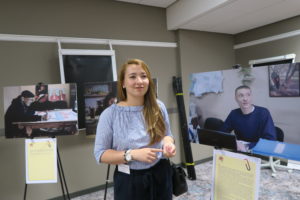Author: Olesya Kravchuk, AFEW International
Last week the photo exhibition ‘Life in the Shadow’ was brought to the Netherlands by public Foundation ‘AIDS Foundation East-West in Kazakhstan.’ It was possible to see the images of people affected by HIV and tuberculosis during Wolfheze workshops in the Hague on 31 May – 2 June.
The main goal of the exhibition is to reduce stigma and discrimination against people with HIV and tuberculosis.
 “We were very lucky with the opportunity to bring the exhibition to the Netherlands and show it to the bigger number of people,” the project manager of AFEW Kazakhstan Kristina Zhorayeva is saying. “Our models were very brave to show their faces and share their personal stories. They wanted to tell people that they are not different and they also have dreams and hopes.”
“We were very lucky with the opportunity to bring the exhibition to the Netherlands and show it to the bigger number of people,” the project manager of AFEW Kazakhstan Kristina Zhorayeva is saying. “Our models were very brave to show their faces and share their personal stories. They wanted to tell people that they are not different and they also have dreams and hopes.”
At the end of March the photo exhibition ‘Life in the Shadow’ was shown in Almaty, Kazakhstan. Some people from Kazakhstan saw the images for the first time in the Netherlands though.
 “I have heard about this exhibition from AFEW, and today I saw it in the Netherlands even though it was displayed in my native Almaty,” the head doctor of one of the private clinics of Almaty Galiya Tulebayeva is smiling. “I look at these pictures of the patients with pleasure. It is great to see that there are smiles on their faces and they are in positive mood.”
“I have heard about this exhibition from AFEW, and today I saw it in the Netherlands even though it was displayed in my native Almaty,” the head doctor of one of the private clinics of Almaty Galiya Tulebayeva is smiling. “I look at these pictures of the patients with pleasure. It is great to see that there are smiles on their faces and they are in positive mood.”
As of February 2017, in Kazakhstan there were registered 29,568 HIV cases. According to the official data, in 2016 there were 14,345 tuberculosis patients registered in the country.
Visitors reviews of the photo exhibition ‘Life in the Shadow’
 Jamshid Gadoev, WHO Country Office for Combating Tuberculosis, Hepatitis and HIV-AIDS in Uzbekistan:
Jamshid Gadoev, WHO Country Office for Combating Tuberculosis, Hepatitis and HIV-AIDS in Uzbekistan:
– Only brave people can show themselves in such a way. They got sick and went through the processes that other people are going through now and do not hesitate to show all of this. On each photo I see a smile. Probably, they are happy with their treatment and are glad that they were rescued. They seem to be happy with their lives.
We also published a book and made a video about what tuberculosis patients feel before, during and after their treatment. We asked our patients to associate tuberculosis with some color, and children were asked to associate it with color and with the animal. Many people said that the disease for them is associated with red, yellow or black. Children usually said that their illness is a red teddy bear. Adults told that for them tuberculosis is black and is associated with the sound of a trumpet. After treatment, these associations often change and colors become brighter.
 Alexei Bobrik, WHO technical specialist on HIV, tuberculosis and hepatitis, WHO Country Office, Ukraine:
Alexei Bobrik, WHO technical specialist on HIV, tuberculosis and hepatitis, WHO Country Office, Ukraine:
– To overcome the burden of these diseases, it is necessary to talk about this problem so that the population knows about it, and the negative attitude towards the diseases decreases with time. It is necessary to communicate information, so that there is no stigma and discrimination. We must know that normal people are vulnerable to these serious diseases as well.




